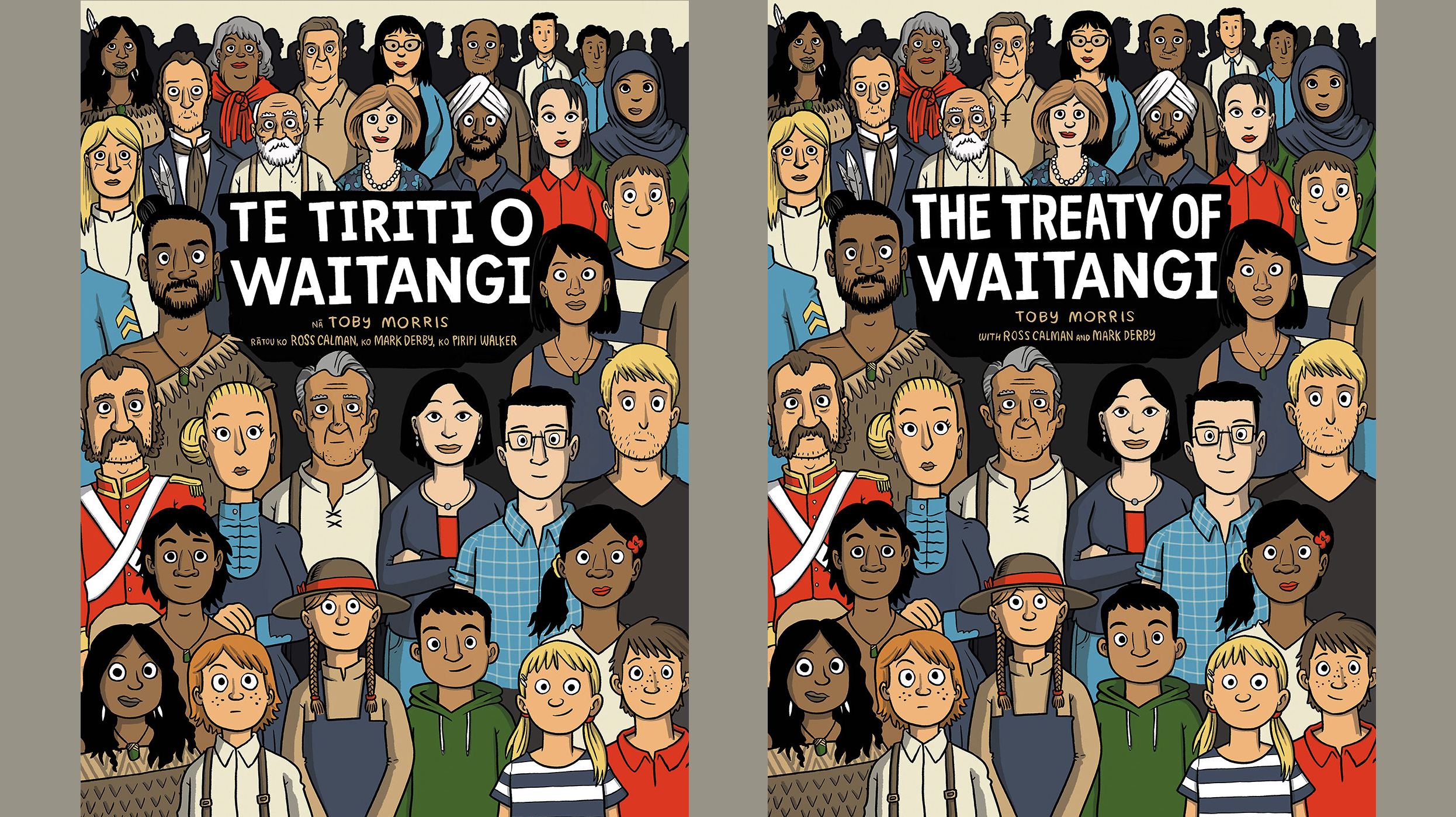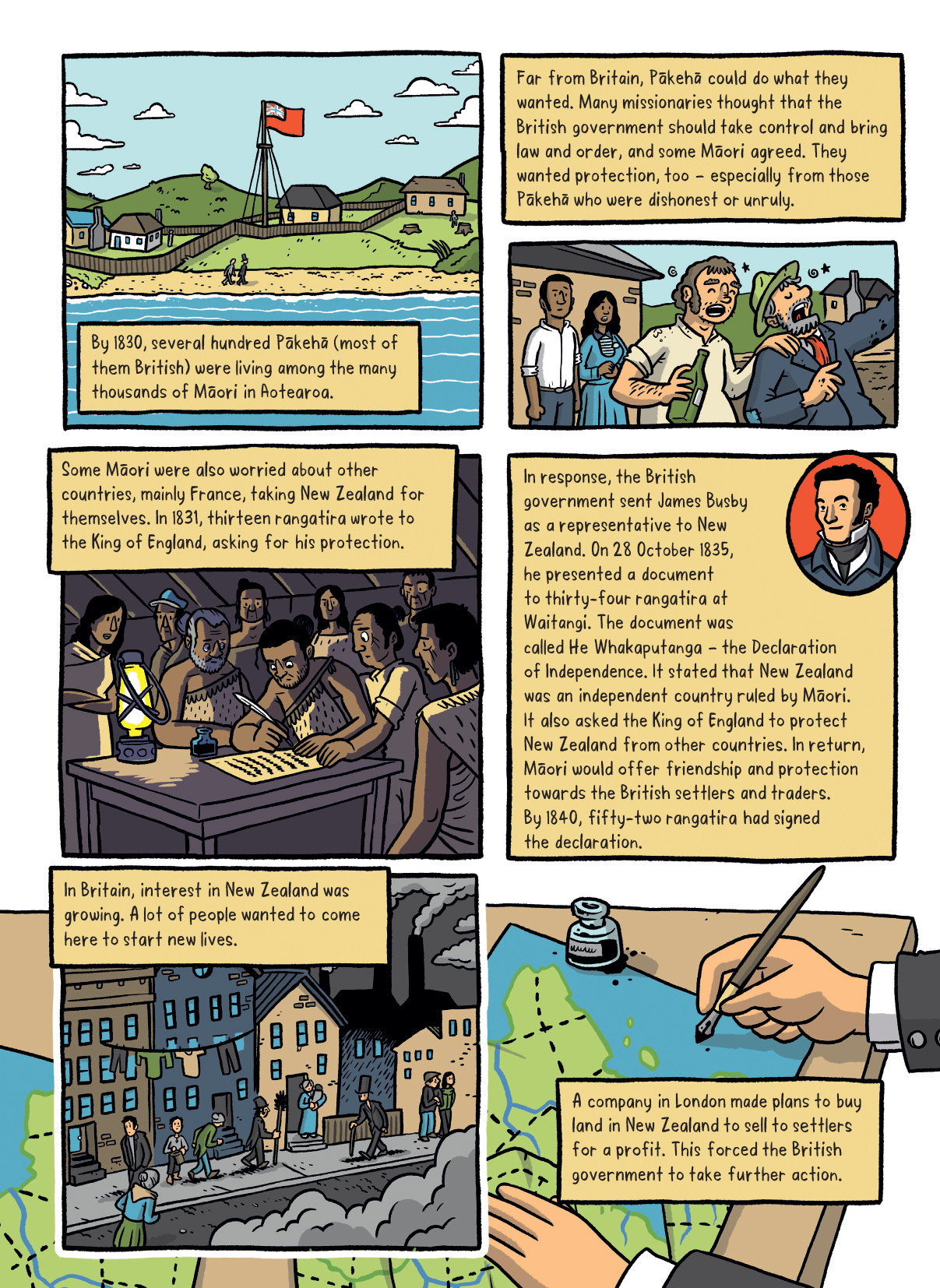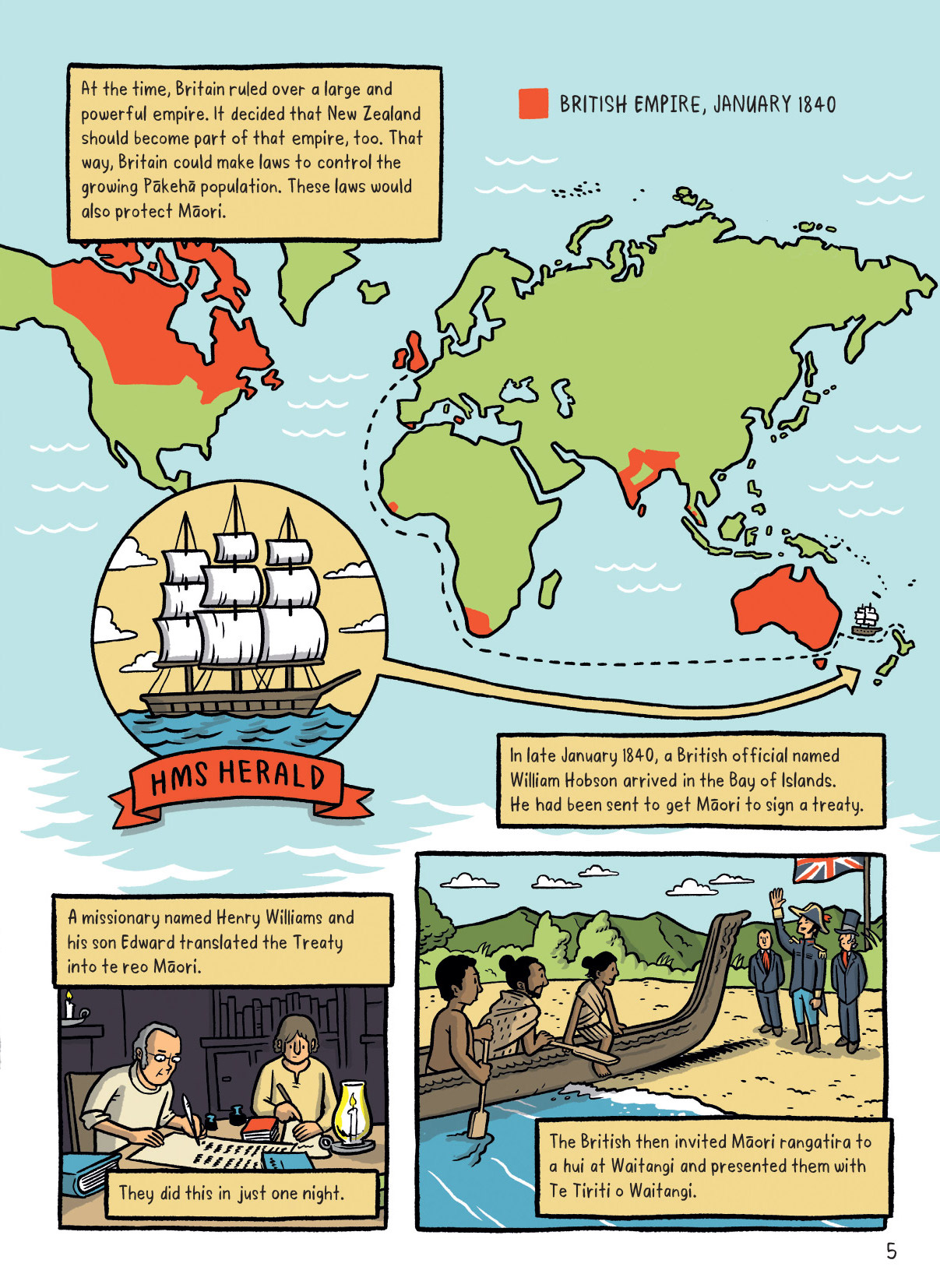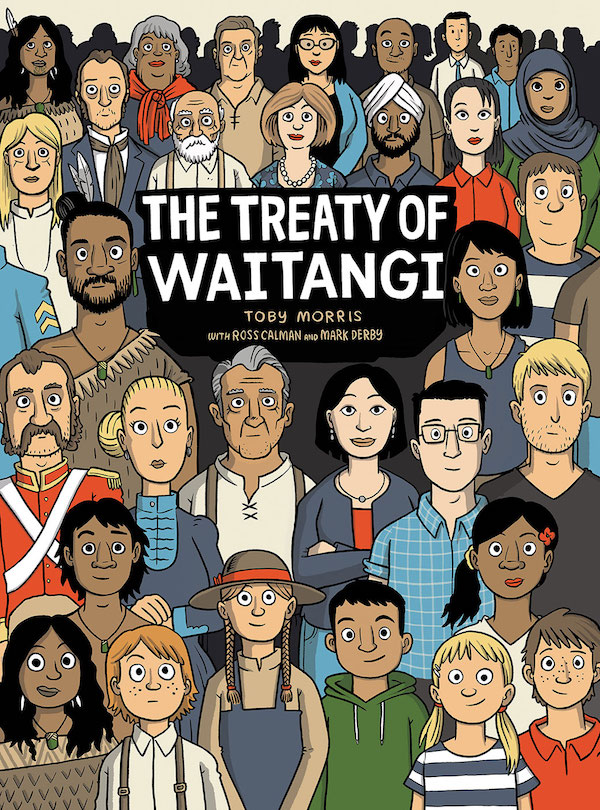Following the release of the School Journal Story Library graphic novel Te Tiriti o Waitangi into schools a year ago, Lift Education have published a larger, bilingual version of the book. This is their first trade publication and unlike anything produced before on this very important kaupapa.
If you would prefer to read this article in te reo Māori, please see our post from yesterday, with the text translated into Māori by Ian Cormack.

At the launch of Te Tiriti o Waitangi earlier this month, more than 250 people turned up to Unity Books Wellington. They sold out instore that evening and Lift Education retrieved another stash to restock them, which has to be every publisher’s dream. In the first week following the book’s launch, Te Tiriti o Waitangi hit #2 for Auckland and #1 for Wellington in Unity’s best seller chart. It has been a runaway hit, and fills a vital space in accessible storytelling of Aotearoa’s history.
To mark the book’s launch, I had the opportunity to quiz Alex Collins, the chief executive of Lift Education, about the book itself and how they undertook such a significant project. Throughout our conversation, themes of collaboration, respect and integrity were evident from the book’s inception to it coming off the printing press.
The project had an unusual inception, as a School Journal Story Library publication aimed at Year 7 and 8 students – teacher notes and audio file are available here. It was initially a piece of Ministry of Education work presenting the Treaty of Waitangi from signing to the current day. But Lift Education have now released the larger format, bilingual version to the wider public, the end result of a complex editorial, publishing and design process. Alex describes it as ‘more of a publisher’s book than an author’s book in a way; it’s been quite a collaborative effort’. It began with the co-authors, Ross Calman and Mark Derby, both of whom had previously written articles for the School Journal, as well as books about the Treaty of Waitangi and New Zealand history.
Publishing content for schools as graphic novels is not new to Lift Education, but once the script had been finalised and passed to illustrator Toby Morris, the project really started to become something special. ‘When we saw Toby’s illustrations, it was so cool! But you could just see it disappearing into schools. We felt that it was too good to not do something else with. So, luckily the Ministry of Education gave us the licence to go ahead, as it’s all their copyright. We decided that it should be a flip book in both languages to respect the bicultural nature of the whole project.’
But you could just see it disappearing into schools. We felt that it was too good to not do something else with.
I wondered if Alex had always hoped that the publication would get a wider audience, but he explained that completing the School Journal contract had been their focus. ‘It wasn’t until it landed on our table after Toby had given it his flavour that we just went “wow, this needs to go further”. He just brought it to life. His magic was what opened it up.’
Before the illustrative aspect was tackled, there had been an extensive process to ensure that the script was both credible and readable. There were also considerations to be made regarding the text being published as a graphic novel, especially with a non-fiction project like this where the content is so important but must be communicated in a limited space. Alex describes finding this balance as ‘accurately saying what you need to say…that you’re saying enough, while also not saying too much because you can’t fit it in.’
To ensure that the content of the book had integrity, Lift Education involved an impressive team to guide them, from educators and historians, language experts to iwi. ‘We wanted to make sure that it was exactly as it should be’, Alex says. As such, key contributors were enlisted, including Hōne Apanui (Ngāti Porou), Dame Claudia Orange, Kate Potter and Ian Cormack (Kāi Tahu, Ngāti Mamoe, Waitaha). ‘They were very helpful in challenging us, pushing us to really go the extra mile. There’s been some really great people involved in it.’

There were a number of practicalities that Alex and his team worked through during the editing and design process. Te Tiriti o Waitangi is twice the size of a School Journal. ‘This is a bit smaller than A4, and not quite as large as Asterix or Tintin books, but we wanted it to be similar. We carefully chose the quality of the paper stock we used… There were other considerations too, as we knew that it would have two covers, so we didn’t have a ‘back’ to put a barcode on. That meant that we incorporated it into one of the t-shirts in Toby’s cover illustration.’
They also made the conscious decision to print the book in Aotearoa. ‘We could have printed it a lot cheaper overseas. But I think that it’s New Zealand’s story, and it should be printed here. We thought it was worthwhile – we were really thinking that this book was going to be a taonga and we wanted to do that justice.’
The translation of things Treaty-related has a difficult history. Any student of te reo Māori knows the challenge of finding English words that accurately capture Māori whakaaro, as there are many indigenous concepts that don’t have an equivalent kupu. But translation is something Lift Education is very comfortable with. ‘We’ve got a great network of people to support us. We do a lot of translation into Pacific languages, including a dual language series, which is in five Pacific languages, and we also do work in the Solomon Islands, Tokelau, Tonga and the Cook Islands.’
Any student of te reo Māori knows the challenge of finding English words that accurately capture Māori whakaaro, as there are many indigenous concepts that don’t have an equivalent kupu.
I was intrigued to know what this translation process had looked like, so Alex explained the ins and outs. ‘We first revised the school version, tweaked it a little bit here and there and then Piripi Walker came in and worked with Ian Cormack. Then Hōne Apanui came in as another Māori voice to review the translation. There was a little bit of negotiating about how something might be said and whether it accurately portrayed what was being said. It was a really interesting process to go through.
‘Piripi is so well known in that space, we couldn’t have gotten anyone better, and even though he’s got such a great reputation already, he was always working with others. So, again humility played into the collaborative nature of the venture. Everyone wanted it to be the best it could. No one had an ego about it. That’s what made it work.’
When I received my copy of Te Tiriti o Waitangi/The Treaty of Waitangi, I was immediately struck by what a lovely publication it is; despite the magazine-like proportions, it’s really comfortable to hold. Those small details such as the glossy title and quality paper stock didn’t go unnoticed. I recognised someone who looks a bit like me (or someone I know) in the sea of New Zealand faces gazing out from the matching front and back covers.
When I received my copy of Te Tiriti o Waitangi/The Treaty of Waitangi, I was immediately struck by what a lovely publication it is.
The visual interpretation of this pivotal moment in Aotearoa’s history is both concise and detailed. Toby Morris introduces us to learning about the Treaty from his own perspective as a Pākehā New Zealander and his clever and relatable style of illustration shines from each page. There’s also a timeline, a map showing the rohe where Te Tiriti was signed and a QR code to follow if you want to read the Treaty itself in 30 languages (as well as NZSL). And then, having made it to halfway, you can flip the whole book over and reread it all in te reo Māori. Mīharo!
It’s certainly a very readable Māori edition, not too complex for second language learners like myself, but with enough interesting kupu hou to prompt further ako. I was moved by how significant it felt to read about Te Tiriti itself in the Māori language. I can imagine the possibilities for young learners in kura kaupapa.

Te Tiriti o Waitangi is the shared agreement underpinning every facet of our bicultural relationships in Aotearoa. And yet, I believe that it is still much misunderstood, misinterpreted or disregarded completely. Unfortunately, many New Zealanders were – and are – not taught the full story of the colonisation of Aotearoa as young people. This complicated past and mamae remains as injustices against tāngata whenua are either unresolved or ongoing.
There’s still enormous inconsistencies in how our history is taught and there’s been decades of inaccuracies and whitewashing in the education system. As a teacher, I often struggled to find relevant, balanced and credible resources on this kaupapa, so I was excited to see this publication going into schools last year. My second response was ‘every home in Aotearoa needs to own this!’ Both my father and older sister are history geeks, so as a child I got to participate in really interesting discussions around our dining table. However, this love of learning about our history isn’t common amongst New Zealand students.
After reading Te Tiriti o Waitangi, I envisioned future graphic novels telling the stories of Parihaka, the Waikato Wars, Gate Pā, the Hīkoi. These important events are often similarly misunderstood so perhaps there’s potential for our country to be re/educated in a similarly accessible format. Alex tells me enthusiastically about Lift Education’s latest School Journal Story Library graphic novel, which is focused on the Dawn Raids. It’s ‘just gone out to schools. We’ve been wanting to do that for a few years. It’s an important piece of New Zealand history, and for most New Zealanders it’s in the past but for many in the Pacific community it needs to become part of conversations in the classroom.’
After reading Te Tiriti o Waitangi, I envisioned future graphic novels telling the stories of Parihaka, the Waikato Wars, Gate Pā, the Hīkoi.
Throughout our discussion, Alex communicated his hope that this book will be a catalyst for a whole new generation of New Zealanders learning our history, and other generations unlearning some myths and gaining some new knowledge too. ‘This book really shows you that we are built on an initial relationship between the Crown and Māori, and then everything else comes from that. We’re hoping that if that’s the only message that gets out there, it’s a powerful thing for the book to have done. We’ve felt that we had a mandate to do this book as it’s from a Pākehā perspective and that’s important for Pākehā to take ownership of. We must remember that both parties signed the treaty. For us, this has been about our love for it; we loved what we saw originally, and thought that it would be so much better in the hands of everyone. It’s priced to be accessible – that was a conscious decision to try and get the message out there.’
And what a very important message. This book is a great way to start some significant dining table conversations throughout Aotearoa.

THE TREATY OF WAITANGI
By Toby Morris, Ross Calman (Ngāti Raukawa, Ngāti Toa, Kāi Tahu) and Mark Derby
Translated into te reo Māori by Piripi Walker (Ngāti Raukawa ki te Tonga).
Published by Lift Education
RRP: $20.00
Nō ngā hau e whā ōku tūpuna, nō Tiamana, nō Kōtirana, nō Ingarangi, nō Airana, nō Peina rātou. Nō reira, he tangata tiriti ahau. E noho ana ahau ki Whanganui.
Toi tū te kupu, toi tū te mana, toi tū te whenua e.

Kay Benseman
Kay Benseman (she/her) is a collector of quirky children's books and kupu hou. In the 90s, she worked in a bookshop and had a 40% staff discount, and her bookshelves have never recovered. With a background in education and the cultural sector, she is now a writer/researcher and Māmā to two curious children. He tāngata Tiriti ia, Kay is Pākehā living on Ngā Rauru whenua in Whanganui.



